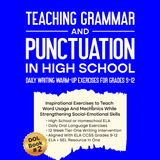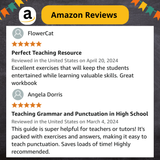Daily Oral Language (DOL) Grammar Warm-Ups for High School ELA 12 Weeks of No-Prep Bell Ringers to Boost Student Writing and Support Social-Emotional Growth | PDF Download
Struggling to squeeze grammar and mechanics into your already-packed ELA schedule?
You're not alone. With over 15 years of experience teaching high school English and SPED, I know the challenge of fitting in direct instruction when there is so much work to be done in a single class period.
When it comes to teaching grammar and punctuation in high school, your first thought might be, “I don’t have time to teach conventions in isolation.” I get it. But after years in the classroom, I’ve learned that explicitly teaching punctuation—even as a quick daily refresher—is one of the most effective ways to improve student writing. Whether it’s their first time learning the rules or just a much-needed review, consistent, direct instruction will prove to be a game-changer, and in the end, it will also prove a time-saver.
I promise you, this daily exercise is quick, engaging, and most importantly EFFECTIVE. If at the end of 12 weeks you don't see significant improvement in your students' understanding of writing conventions, email me and I'll refund your money. That's how confident I am that you and your students will benefit from this resource.
Visit my new Youtube channel to view an overview of how to use this daily exercise in the classroom: WATCH HERE
PDF Instant Download
WHY I CREATED THIS:
I started creating these Daily Oral Language (DOL) writing warm-ups years ago when I realized my high school students didn’t know how to use even the most basic punctuation correctly. I wanted a simple, consistent daily routine that used repetition to reinforce essential grammar and mechanics skills—but I couldn’t find anything on the market that was both quick and truly effective.
Most of the resources out there were either too time-consuming, too boring, or missed the most common student errors entirely. As the saying goes, necessity is the mother of invention—so I decided to create my own daily exercises. Because I'm passionate about adressing the social-emotional domain in the classroom, I also embedded inspirational messages within each daily paragraph/editing exercise to prompt self-reflection and personal growth.
I immediately saw that my students were engaged with the daily acitivty AND that it was effective! What began as a classroom solution has now become a trusted tool used by thousands of teachers. I've invested countless hours creating this resource so you don't have to!
I'm sharing a quick, meaningful routine that makes grammar instruction doable for teachers and digestible for students.
Why Teachers Love This:
-
-
Takes just 5 minutes a day
-
Targets real grammar, punctuation, and sentence structure errors
-
Embedded SEL concepts build metacognition and inspire students
-
Improves editing, writing fluency, and critical thinking over time
-
Establishes a meaningful daily routine, which supports behavior management
-
What You’ll Get
-
12 weeks of DOL warm-ups (1 paragraph per day, 5 per week) in PDF digital format
-
60 engaging daily exercises/ practice paragraphs to teach grammar and punctuation with a unique social-emotional twist
-
Teacher answer key included
-
17 bonus mini-lessons to clarify commonly misunderstood grammar and punctuation.
-
List of ELA CCSS aligned with grades 9-12
Designed by a Veteran Teacher Who Gets It
I’ve used this exact format with high school students across a wide range of reading and writing levels—including special education, general education, and intervention classes. I created this resource because my students needed grammar instruction that was consistent, purposeful, and—most importantly—non-intimidating.
These warm-ups are a simple, powerful way to build students’ confidence and competence without overwhelming them (or you).
Perfect For:
- High School ELA Teachers
- SPED and Resource Classes
- ELA Intervention
- Homeschool High School Curriculum
- Test Prep Support (NWEA, PSAT, ACT Writing)
Prefer the printed, published version
of this resource?
Find it HERE on Amazon.
This is DOL Book # 2. Find DOL Book #1 in my store HERE or on Amazon HERE.
Ready to Make Grammar and Punctuation Part of Your Daily Routine?
Click Add to Cart and download instantly. Start tomorrow.
Your students—and your future self—will thank you.
































